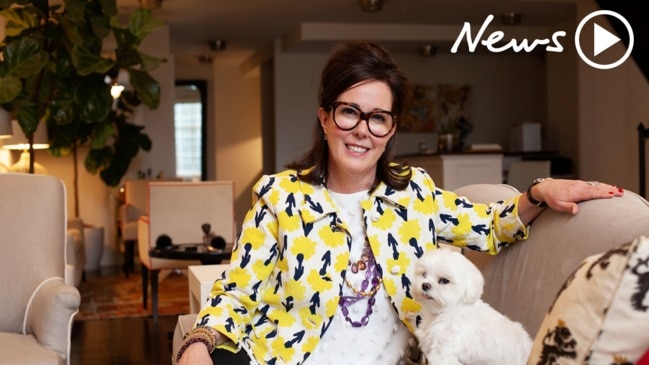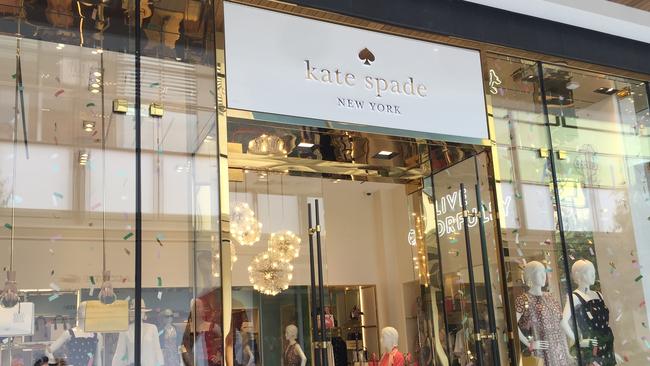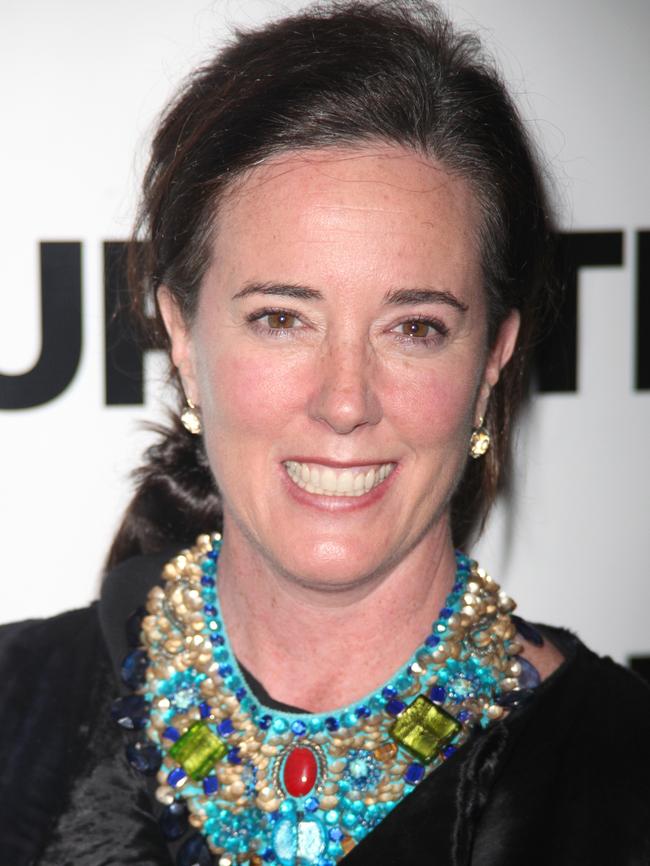Designer Kate Spade found dead in New York apartment
Fashion designer Kate Spade, 55, has been found dead from an apparent suicide at her Manhattan apartment.

The fashion designer Kate Spade—whose sophisticated handbags with a touch of whimsy represented a rite of passage for a generation of young, urban women—was found dead from an apparent suicide at her Manhattan apartment Tuesday morning.
The 55-year-old, who sold a stake in her namesake brand 19 years ago and cut ties with it in 2007, had returned to the fashion business in 2016, designing shoes and handbags under the brand name Frances Valentine. She was married to her business partner, Andy Spade, who was the brother of actor David Spade. The couple have a 13-year-old daughter, who wasn’t home at the time of the incident, an official said.
Officials said the designer was found by her housekeeper.
“It appears at this point in time to be a tragic case of apparent suicide,” NYPD Chief of Detectives Dermot Shea said at press briefing on Tuesday. “It is early in the investigation. There was a suicide note left at the scene.”
A spokeswoman for the company that owns the Kate Spade brand said, “Although Kate has not been affiliated with the brand for more than a decade, she and her husband and creative partner, Andy, were the founders of our beloved brand. Kate will be dearly missed. Our thoughts are with Andy and the entire Spade family at this time.”
Paula Fiedler, a neighbor in Ms Spade’s apartment building, said “everyone was crying” when they were informed of her death this morning.

Ms Fiedler described Ms Spade as a “determined person” who she would frequently see working out in the building gym.
“There is nothing I can say bad about her. She was warm, smiling, always willing to share. All of us are so sad.”
The Kate Spade brand has changed hands several times since the founders first sold a controlling stake to Neiman Marcus in 1999. The high-end retail chain agreed to sell the brand in 2006 to Liz Claiborne Inc., which later changed its corporate name to Kate Spade & Co. The company was acquired last year by rival Coach Inc., now known as Tapestry Inc.
The designer’s new venture, Frances Valentine, hasn’t fared as well, people familiar with the situation said. Some retailers that had initially carried the line such as Bloomingdale’s have dropped it.
Memorials quickly surfaced on social media as news of the designer’s death spread, with people including designer Kenneth Cole and singer Josh Groban expressing their condolences.
“My grandmother gave me my first Kate Spade bag when I was in college. I still have it. Holding Kate’s family, friends and loved ones in my heart,” Chelsea Clinton said in a tweet.
Others used the surprising news to raise awareness about suicide
Good afternoon Missy Peppers - no code. Deep gratitude for Kate Spade sharing her talents with the world, a cherished memory of my grandmother giving me my first grownup bag and a continued holding of Kate’s family, friends and loved ones in my heart. Blessings to you & yours. https://t.co/TA05ixjz9j
— Chelsea Clinton (@ChelseaClinton) June 5, 2018
“Kate Spade’s tragic passing is a painful reminder that we never truly know another’s pain or the burden they carry,” Ivanka Trump said in a tweet.
Kate Spade’s tragic passing is a painful reminder that we never truly know another’s pain or the burden they carry. If you are struggling with depression and contemplating suicide, please, please seek help. https://t.co/eruSexNoGj
— Ivanka Trump (@IvankaTrump) June 5, 2018
The designer, born Katherine Noel Brosnahan in Kansas City, was one of six children. Her mother was a former airline attendant who later became a real-estate agent. The designer met her husband when she was a student at Arizona State University, where she graduated with a journalism degree. “Andy and I met in a little clothing store,” Ms Spade said in a 2016 interview with The Wall Street Journal.
The designer said she showed an early flair for fashion. “I would have my mother take me to vintage stores and wear leopard swing coats and cigarette pants,” she said in the interview. “In Kansas City I looked very odd.”
The couple moved to New York, where Ms Spade worked at Mademoiselle magazine, where she started as an assistant, “tying models’ shoes” and “getting hairstylists Snickers” as she worked her way up to fashion editor, she told NPR in a 2017 interview.
In the early 1990s, at a Mexican restaurant in New York, Mr Spade asked her, “ ‘What about handbags?’ ” she recalled. “And I said, ‘Honey, you just don’t start a handbag company.’ And he said, ‘Why not? How hard could it be?’ ”
Ms Spade said she felt handbags at that time were too complicated, and there was a dearth of bags with clean, simple shapes. She began cutting patterns out of white paper and eventually found a pattern maker and potato-sack company willing to sell her fabric to turn her ideas into bags.

The couple debuted the bags at a trade show in New York and landed just two buyers, leaving Ms Spade in tears and convinced she should quit. When she went home and told Mr Spade who the buyers were—the retailers Barneys and Fred Segal—he said, “ ‘No, keep it going,’ ” she recalled.
The couple, along with two partners, started the business in 1993 and opened their first handbag shop three years later. They sold a 56% stake in the business to Neiman Marcus in 1999 for $33.6 million.
“It became a cultural phenomenon,” said William McComb, Liz Claiborne’s former chief executive, who said the brand resonated far beyond the size of the company. Kate Spade had less than $100 million in annual sales when Liz Claiborne bought it, he said.
Mr McComb oversaw the brand’s expansion to include hundreds of retail stores and new product lines such as men’s accessories, stationery and housewares. By the time Coach bought it, the brand had more than $1 billion in annual sales.
Ultimately, though, growth of the Kate Spade brand lagged behind that of Coach and Michael Kors Holdings Ltd. in what is known as the “affordable luxury” accessories market.
The merger with Coach last year was an attempt by the two companies to adapt to slowing growth in the handbag market. Women have been trading down to smaller, less expensive purses, and discounting has pressured profits at both Kate Spade and Coach. The result of the merger, Tapestry, has nearly $6 billion in annual sales and 1,300 retail stores.
The Kate Spade and Coach brands have been kept separate after the corporate combination. Tapestry has been scaling back distribution of Kate Spade merchandise in an effort to reduce discounting, much as it did with its Coach label. Kate Spade’s global comparable store sales fell 9% for the most recent period, reflecting the pullback.
The Kate Spade store on Madison Avenue in New York was open for business Tuesday, with a handful of customers perusing the shop’s racks of flowy summer dresses and strappy sandals. Today, Kate Spade has more than 140 U.S. retail stores and more than 175 abroad.
“She was someone I looked up to in life,” said JoJo Deady, of New York City, a 26-year-old shopper at the store. “She was light, happy and fun. This shows you don’t know what anyone is going through.”
Rachel Beck, 53, was shopping in the neighborhood when she heard the news and decided to stop by and pay her condolences to staff at the store. She said she didn’t know Ms. Spade was no longer involved in her eponymous brand.
Carrying a cream-colored Kate Spade cross-body purse, Ms. Beck decided to purchase another in a different color. “I thought it would be a nice thing to do today,” she said.
Anyone who may be feeling distressed can contact the following organisations for support. SANE Helpline 1800 18 72 63 Lifeline 131 114 beyondblue 1300 22 4636
The Wall St Journal


